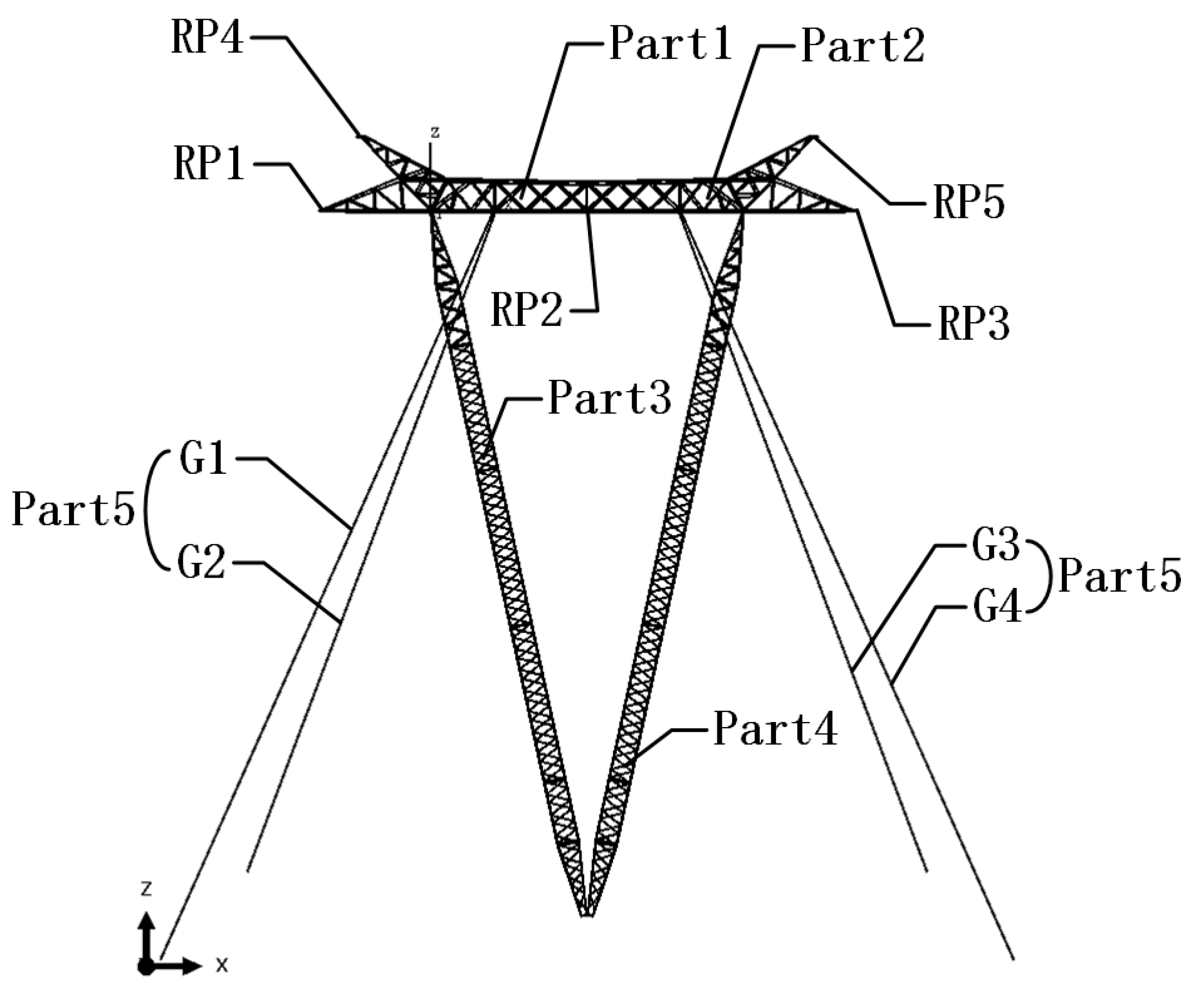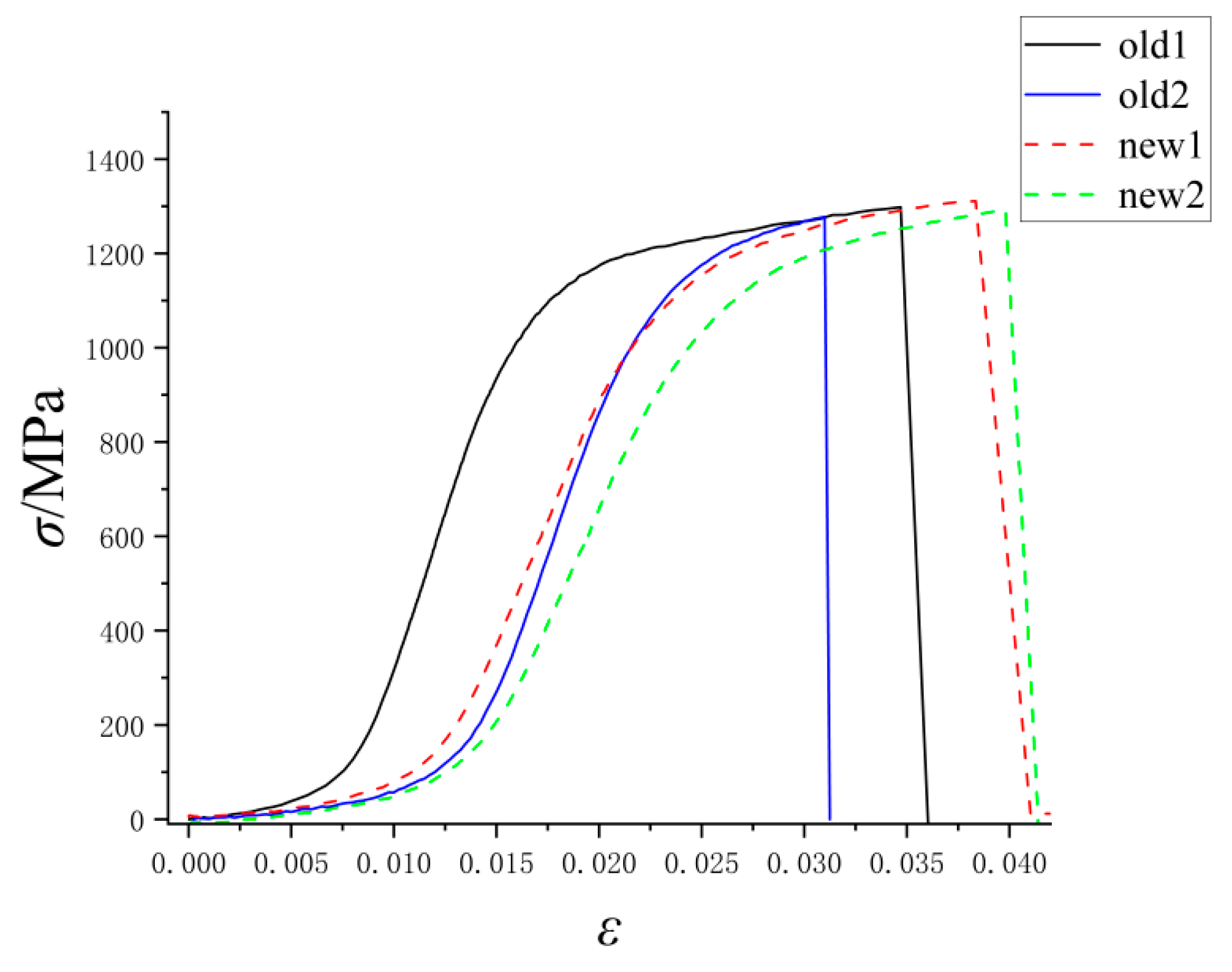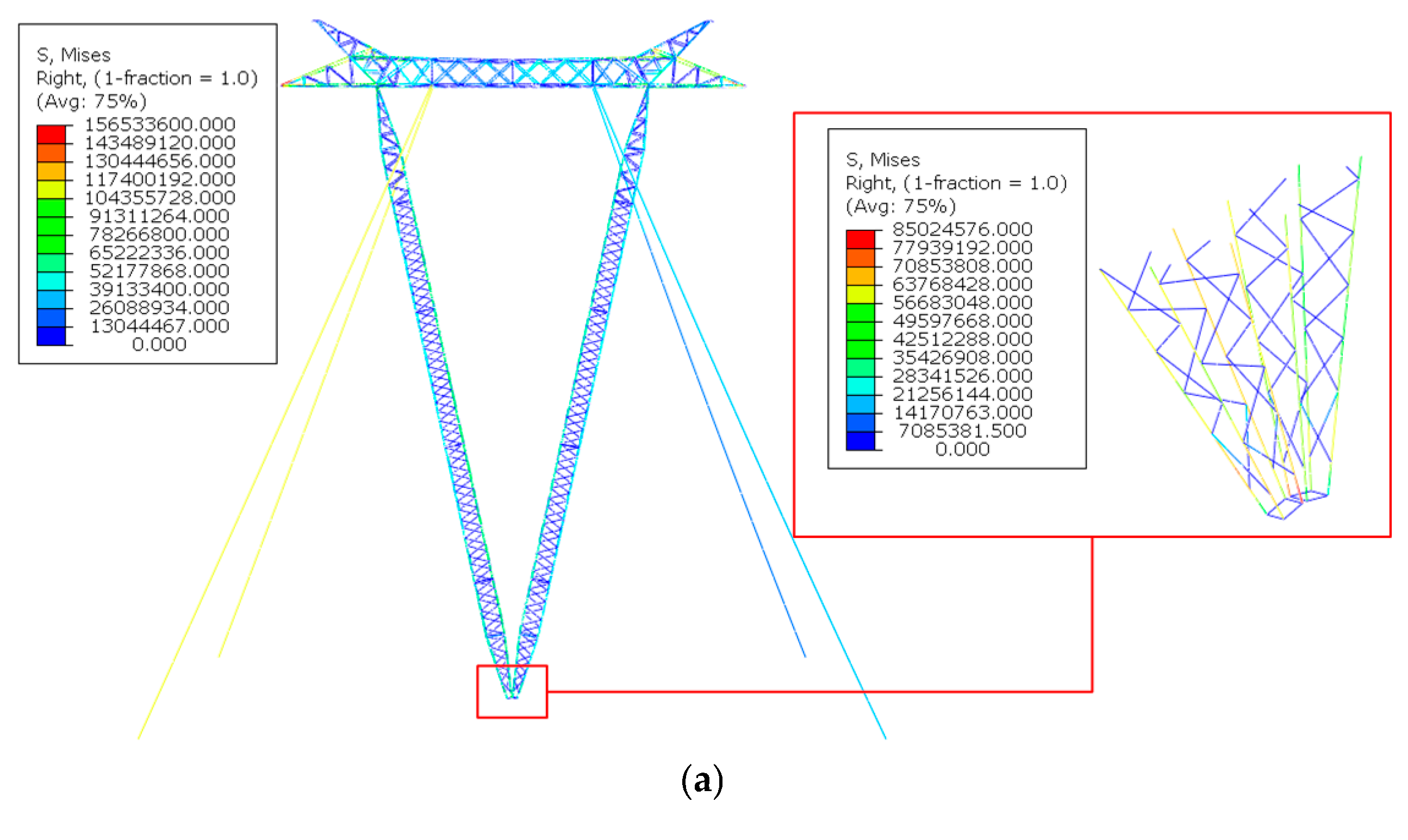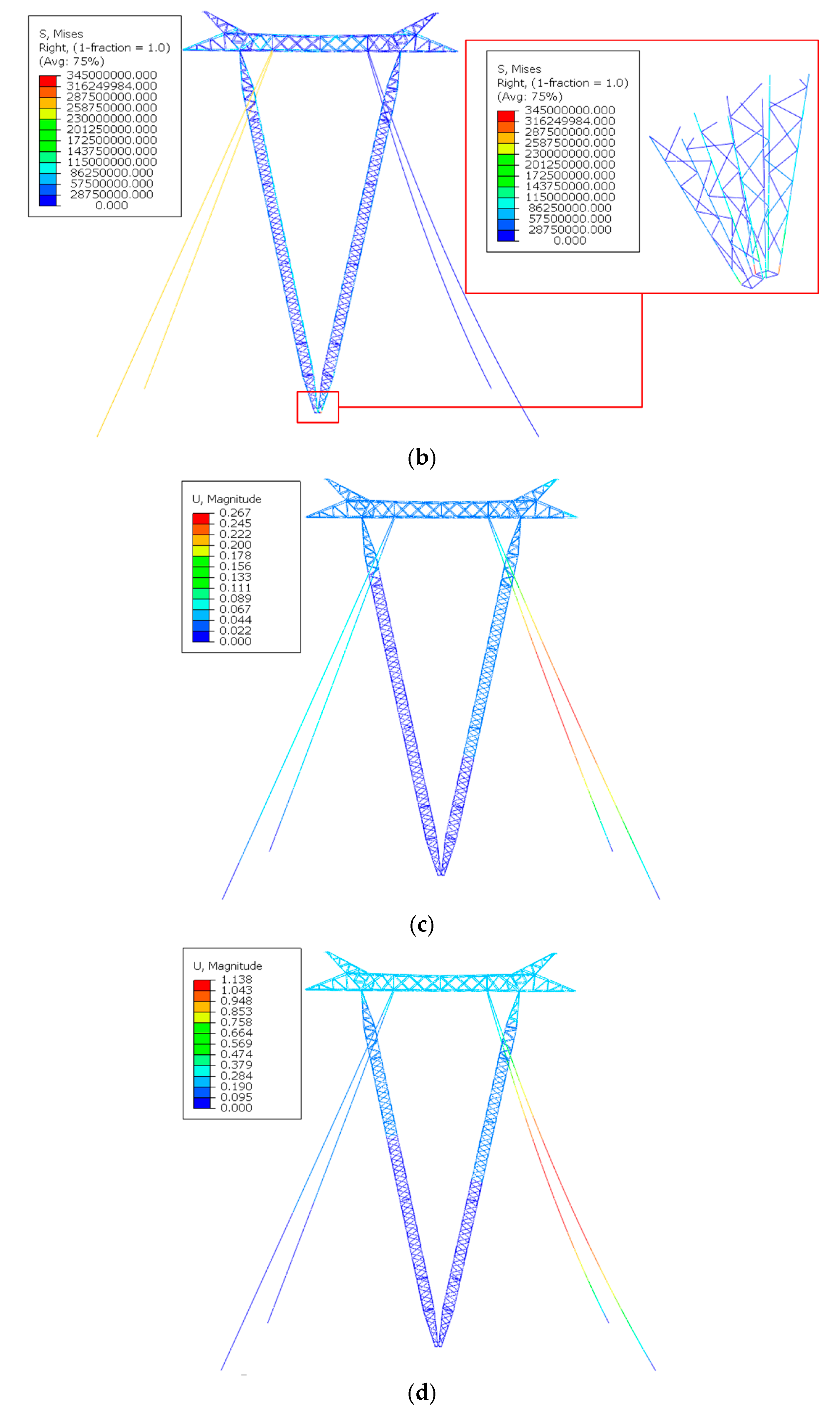Study of the Static Performance of Guyed Towers in High-Voltage Transmission Lines
Abstract
1. Introduction
2. Tension Force and Material Properties of Guy Wires
2.1. Tension Force Test
2.2. Material Properties Testing of Guy Wire
3. Finite Element Model for the Guyed Tower
4. Simulation Results
- (1)
- Under the ice loading condition, when Towers 1 and 2 are configured with hinged bases, the maximum stresses of the tower body are 85.02 MPa and 91.69 MPa, respectively. When the base is fixed, the maximum stresses of the tower body are 154.70 MPa and 160.30 MPa. This indicates that the differences in internal forces of the guy lines have a relatively minor impact on the maximum stress of the tower body under ice loading conditions. Given that the current internal forces in the guy wires differ significantly from the original design conditions, whether the base is pinned or fixed, the maximum stress in the tower body shows notable variations, with Towers 1 and 2 exhibiting approximately a 20% reduction in maximum stress compared to Tower 3.
- (2)
- Under the ice loading condition, analysis of the maximum stress at the tower base indicates significant variations between the hinged and fixed conditions. Compared to the hinged base condition, the maximum stresses for Towers 1, 2, and 3 increase by 82%, 75%, and 61%, respectively, when the bases are fixed. When the initial stress in the guy wires is relatively high, the magnitude of the maximum stress increase tends to decrease. This is attributed to the greater initial stress enhancing the guy wires’ capacity to resist lateral loads, thereby reducing the bending moments experienced at the fixed base and narrowing the difference in maximum stress compared to the pinned condition.
- (3)
- Under the ice loading condition, it was observed that for Towers 1, 2, and 3, the final stresses of the four groups of guy wires in the pinned configuration are similar to those in the fixed configuration, indicating that the final stress levels are largely independent of the boundary conditions at the tower base. A comparison of stresses among the guy lines of Towers 1, 2, and 3 reveals that Tower 3 exhibits the highest final stresses, followed by Tower 2, with Tower 1 showing the lowest. This suggests a direct proportional relationship between guy wire stress and initial stress under the ice loading conditions. Notably, under the ice loading condition, who has a small lateral load, the stresses in guy wires G3 and G4 of Tower 1 are only around 27 MPa. Thus, if the current tension in the guy wires is too low, they may be in a fully relaxed state or experiencing excessively low stress under the ice loading.
- (4)
- Analysis of maximum displacement and the inclination angle of the tower body shows that, compared to the pinned condition, the maximum displacements and inclination angles are relatively smaller when the towers are fixed. Given the relatively low initial stress, the reduction in maximum displacement and inclination angle for Tower 1 when transitioning from pinned to fixed conditions is significant. A comparison of the maximum displacements and inclination angles of Towers 1, 2, and 3 indicates that they decrease with an increase in the initial stress. When compared to Tower 3, the displacements for Tower 1 increase by 24.3% and 24.0% under hinged and fixed conditions, respectively, while maximum displacements of Tower 2 increase by 18.1% and 17.0%. Therefore, the increase in tower body displacement, compared to the design state, is related to the initial stress in the guy lines.
- (1)
- Similar to the ice accretion load scenario, under both pinned and fixed base conditions, the maximum stress in the tower structure is minimally influenced by the initial tensile stress of the guy wires. However, within the same tower, the maximum stress in the fixed model significantly exceeds that of the pinned model. Specifically, when compared to the hinged configuration, the maximum stresses in Towers 1, 2, and 3 under the fixed conditions increase by 270%, 227%, and 137%, respectively. This indicates that under the influence of strong lateral wind loads, converting the tower base from a pinned to a fixed configuration significantly amplifies the maximum stress at the base. Furthermore, when the initial tensile stress is relatively low, the local stress after fixing reaches the yield stress.
- (2)
- Under the high wind load conditions, when in pinned configuration, the stress in the tension wires G1 and G2 of Towers 1, 2, and 3 is equivalent to that of the fixed connection, exceeding 200 MPa. Conversely, the stress on the guy wires G3 and G4 of all towers is very low, among which the guy wires G3 and G4 of tower 1 and tower 2 are both less than 7 MPa. This indicates that under significant lateral wind loading, the ultimate stress levels in the guy wires are largely independent of the connection configuration at the base of the towers and are more closely related to the initial stress in the guy wires and the direction of the wind. Consequently, if the current tension in the guy wires is insufficient, they may reach a state of complete slackness under the high wind loads, which poses a risk to structural safety.
- (3)
- The analysis of maximum displacements and tower inclination angles reveals that changing the base connection from pinned to fixed has a minimal impact on the maximum displacements and angular changes in each tower. Unlike scenarios involving ice accumulation, the maximum displacements and tower inclination angles in this case exhibit a significant increase. This is primarily due to the lateral load component of the wind forces. As the initial tensile stress in the guy wires increases, the maximum displacement and tower inclination angle decrease; furthermore, the changes observed when transitioning from pinned to fixed connections are also less pronounced. Specifically, in comparison to Tower 3, Tower 1 experiences increases in maximum displacement of 109% and 107% under the hinged and fixed conditions, respectively. Tower 2 shows increases of 57% and 56% under the same conditions. Consequently, under the high wind load conditions, a reduction in the initial tensile stress of the guy wires significantly compromises the structural safety of the towers.
5. Discussions
6. Conclusions
- When the tower base is either pinned or fixed, the difference in actual guy tension levels between Towers 1 and 2 under the ice and wind loads has a minimal impact on the maximum stress in the tower body. However, it significantly influences the maximum displacement and inclination angle of the tower body.
- The type of base constraint (pinned or fixed) results in notable differences in maximum stress in the tower body under both load conditions. The lower the existing guy tension level, the more pronounced this difference becomes. Specifically, under high wind load conditions with a fixed base, the maximum base stress in Tower 1 is 270% greater than when the base is pinned.
- The initial tension level of the guy wires has a substantial effect on guy wire tension under both the ice and wind loads. Some guy wires in Towers 1 and 2 may fully slacken under relatively low ice or wind load conditions, which can threaten the structural stability of the guyed tower.
- Additionally, with a fixed base connection, local yield failure at the base of Tower 1 may occur when subjected to 85% of the design wind load level.
Author Contributions
Funding
Data Availability Statement
Conflicts of Interest
References
- Titus, H.M.; Jayachandran, S.A. A flexibility approach for geometric nonlinear static analysis of guyed masts. Structures 2024, 70, 107842. [Google Scholar] [CrossRef]
- Liu, S.; Zhang, W.; Li, Q.; Yan, S.; Zhang, S.; Li, C.; Li, L. Engineering method for quantifying the coupling effect of transmission tower-line system under strong winds. J. Wind Eng. Ind. Aerodyn. 2024, 255, 105954. [Google Scholar] [CrossRef]
- Zhu, C.; Yang, Q.; Huang, G.; Zhang, X.; Wang, D. Fragility analysis and wind directionality-based failure probability evaluation of transmission tower under strong winds. J. Wind Eng. Ind. Aerodyn. 2024, 246, 105668. [Google Scholar] [CrossRef]
- Hou, G.; Muraleetharan, K.K.; Panchalogaranjan, V.; Moses, P.; Javid, A.; Al-Dakheeli, H.; Bulut, R. Resilience assessment and enhancement evaluation of power distribution systems subjected to ice storms. Reliab. Eng. Syst. Saf. 2022, 230, 108964. [Google Scholar] [CrossRef]
- Max Irvine, H.M. Cable Structures; MIT Press: Cambridge, MA, USA, 1981; pp. 135–146. [Google Scholar]
- Jiang, L.; Cao, Z.; Tang, B.; Chen, B. Safety Evaluation Method of Guyed Tower Based on Bayesian Network. Spec. Struct. 2024, 41, 18–24. [Google Scholar]
- Wang, J.; Li, Z.; Liang, Y.; Meng, G. Safety evaluation of transmission lines considering meteorological factors. J. Electr. Power Sci. Technol. 2023, 38, 210–217. [Google Scholar]
- Tan, R.; Sun, J.H.; Dang, K.N.; Yue, X. Research on Design Safety of Extra-High Transmission Tower Structure. Power Syst. Clean Energy 2013, 29, 93–97. [Google Scholar]
- Zhao, Q.; Wang, D. The design and calculation on strength tests of 500kV guyed transmission tower under static wind load. In Proceedings of the International Conference on Multimedia Technology, Hangzhou, China, 26–28 July 2011; pp. 1796–1799. [Google Scholar]
- Jiang, T.; Zhang, Y.; Wang, Y.; Yu, B.; Zhang, Y.; Ge, Y. Research on the Safety of Transmission Tower Line System Under Uneven Settlement. Constr. Technol. 2018, 47, 132–136. [Google Scholar]
- Fu, X.; Li, H.N. Uncertainty analysis of the strength capacity and failure path for a transmission tower under a wind load. J. Wind Eng. Ind. Aerodyn. 2018, 173, 147–155. [Google Scholar] [CrossRef]
- GB/T 228.1-2021; China National Standardization Administration, Metallic Materials—Tensile Testing—Part 1: Method of Test at Room Temperature. National Standards of the People’s Republic of China: Beijing, China, 2021.
- GB 50545-2010; China National Standardization Administration, Code for Designing of 110~750 kV Overhead Transmission Line. National Standards of the People’s Republic of China: Beijing, China, 2010.






| Tower | Wire | N0,i (kN) | N0,av (kN) | D0,i (mm) | D0,av (mm) | σG0,t (MPa) | ||||
|---|---|---|---|---|---|---|---|---|---|---|
| 1 | 2 | 3 | 1 | 2 | 3 | |||||
| Tower 1 | G1A | 4.2 | 3.8 | 3.9 | 3.97 | 12.85 | 12.96 | 13.16 | 12.99 | 30.0 |
| G1B | 6.3 | 6.2 | 5.8 | 6.10 | 12.94 | 12.91 | 13.00 | 12.95 | 46.3 | |
| G2A | 5.2 | 5.6 | 5.7 | 5.50 | 12.96 | 12.88 | 12.95 | 12.93 | 41.9 | |
| G2B | 6.7 | 6.8 | 7.0 | 6.83 | 12.89 | 12.83 | 13.01 | 12.91 | 52.2 | |
| G3A | 4.8 | 4.4 | 4.0 | 4.4 | 13.24 | 13.40 | 13.80 | 13.48 | 30.8 | |
| G3B | 3.6 | 3.5 | 3.9 | 3.67 | 13.08 | 13.60 | 13.70 | 13.46 | 25.8 | |
| G4A | 4.8 | 4.7 | 4.8 | 4.77 | 12.91 | 12.96 | 13.03 | 12.97 | 36.1 | |
| G4B | 4.0 | 3.9 | 4.0 | 3.97 | 12.87 | 13.08 | 13.17 | 13.04 | 29.7 | |
| Tower 2 | G1A | 9.1 | 9.4 | 9.4 | 9.30 | 14.53 | 14.36 | 14.13 | 14.34 | 57.6 |
| G1B | 9.1 | 9.1 | 9.3 | 9.14 | 14.47 | 14.19 | 14.39 | 14.35 | 56.5 | |
| G2A | 12.0 | 12.5 | 12.3 | 12.26 | 14.36 | 14.31 | 14.26 | 14.31 | 76.2 | |
| G2B | 9.4 | 9.3 | 9.6 | 9.43 | 14.34 | 14.33 | 14.22 | 14.30 | 58.7 | |
| G3A | 6.9 | 7.1 | 6.8 | 6.93 | 14.26 | 14.25 | 14.31 | 14.27 | 43.3 | |
| G3B | 8.3 | 8.2 | 8.2 | 8.23 | 14.25 | 14.46 | 14.27 | 14.33 | 51.0 | |
| G4A | 9.8 | 9.6 | 9.6 | 9.67 | 14.41 | 14.25 | 14.42 | 14.36 | 59.7 | |
| G4B | 8.9 | 9.1 | 9.0 | 9.00 | 14.34 | 14.39 | 14.36 | 14.36 | 55.6 | |
| Model | σG0 (MPa) | |||
|---|---|---|---|---|
| G1 | G2 | G3 | G4 | |
| Tower 1 | 38.1 | 47.0 | 28.3 | 33.9 |
| Tower 2 | 57.0 | 67.5 | 47.2 | 58.6 |
| Tower 3 | 140.0 | 140.0 | 140.0 | 140.0 |
| Model | Boundary Condition | σG/MPa | Umax (mm) | δU (%) | β (°) | δβ (%) | σF MPa | |||
|---|---|---|---|---|---|---|---|---|---|---|
| G1 | G2 | G3 | G4 | |||||||
| Tower 1 | Hinged | 112.40 | 113.10 | 26.62 | 28.67 | 53.02 | - | 0.0534 | - | 85.02 |
| Fixed | 112.10 | 112.60 | 27.11 | 28.72 | 52.68 | 0.64 | 0.0528 | 1.12 | 154.70 | |
| Tower 2 | Hinged | 116.80 | 117.90 | 48.90 | 48.93 | 50.39 | - | 0.0425 | - | 91.69 |
| Fixed | 116.30 | 118.00 | 48.83 | 49.49 | 49.70 | 1.37 | 0.0421 | 0.94 | 160.30 | |
| Tower 3 | Hinged | 206.80 | 206.80 | 135.00 | 135.00 | 42.65 | - | 0.0510 | - | 112.90 |
| Fixed | 206.90 | 206.30 | 135.60 | 135.00 | 42.49 | 0.38 | 0.0506 | 0.78 | 181.90 | |
| Model | Boundary Condition | σG/MPa | Umax (mm) | δU (%) | β (°) | δβ (%) | σF MPa | |||
|---|---|---|---|---|---|---|---|---|---|---|
| G1 | G2 | G3 | G4 | |||||||
| Tower 1 | Hinged | 267.40 | 268.90 | 4.62 | 4.81 | 238.8 | - | 0.3562 | - | 93.31 |
| (267.50) | (269.00) | (4.88) | (5.10) | (227.6) | (0.3391) | (93.38) | ||||
| Fixed | 262.50 | 264.20 | 4.75 | 4.79 | 233.8 | 2.09 | 0.3485 | 2.16 | 345.00 | |
| (262.60) | (264.60) | (5.03) | (5.07) | (222.9) | (2.07) | (0.3320) | (2.09) | (345.00) | ||
| Tower 2 | Hinged | 219.80 | 221.20 | 5.93 | 6.19 | 179.5 | - | 0.2653 | - | 94.02 |
| (220.10) | (221.60) | (6.44) | (6.72) | (168.7) | (0.2488) | (94.17) | ||||
| Fixed | 216.90 | 218.40 | 6.00 | 6.27 | 176.4 | 1.73 | 0.2608 | 1.70 | 307.60 | |
| (217.40) | (219.00) | (6.51) | (6.82) | (165.8) | (1.72) | (0.2446) | (1.69) | (295.90) | ||
| Tower 3 | Hinged | 249.60 | 249.60 | 28.52 | 28.51 | 114.4 | - | 0.1644 | - | 99.06 |
| (257.40) | (257.40) | (36.33) | (36.32) | (113.0) | (0.1611) | (101.00) | ||||
| Fixed | 248.70 | 248.30 | 29.46 | 29.02 | 113.2 | 1.05 | 0.1627 | 1.03 | 234.80 | |
| (256.60) | (256.20) | (37.37) | (36.91) | (112.0) | (0.88) | (0.1596) | (0.93) | (234.70) | ||
| Tower | Load | Boundary Condition | ΔL (%) |
|---|---|---|---|
| Tower 1 | Strong wind | Pinned | 30 |
| Tower 1 | Strong wind | Fixed | 30 |
| Tower 2 | Strong wind | Pinned | 45 |
| Tower 2 | Strong wind | Fixed | 45 |
Disclaimer/Publisher’s Note: The statements, opinions and data contained in all publications are solely those of the individual author(s) and contributor(s) and not of MDPI and/or the editor(s). MDPI and/or the editor(s) disclaim responsibility for any injury to people or property resulting from any ideas, methods, instructions or products referred to in the content. |
© 2024 by the authors. Licensee MDPI, Basel, Switzerland. This article is an open access article distributed under the terms and conditions of the Creative Commons Attribution (CC BY) license (https://creativecommons.org/licenses/by/4.0/).
Share and Cite
Chen, H.; Wang, Y.; Yin, H.; Xia, L.; Wan, H.; Kalungi, M.P.; Zhu, A. Study of the Static Performance of Guyed Towers in High-Voltage Transmission Lines. Buildings 2024, 14, 3960. https://doi.org/10.3390/buildings14123960
Chen H, Wang Y, Yin H, Xia L, Wan H, Kalungi MP, Zhu A. Study of the Static Performance of Guyed Towers in High-Voltage Transmission Lines. Buildings. 2024; 14(12):3960. https://doi.org/10.3390/buildings14123960
Chicago/Turabian StyleChen, Haoyuan, Yongan Wang, Hong Yin, Liwei Xia, Hengbang Wan, Musoke Paul Kalungi, and Aizhu Zhu. 2024. "Study of the Static Performance of Guyed Towers in High-Voltage Transmission Lines" Buildings 14, no. 12: 3960. https://doi.org/10.3390/buildings14123960
APA StyleChen, H., Wang, Y., Yin, H., Xia, L., Wan, H., Kalungi, M. P., & Zhu, A. (2024). Study of the Static Performance of Guyed Towers in High-Voltage Transmission Lines. Buildings, 14(12), 3960. https://doi.org/10.3390/buildings14123960





